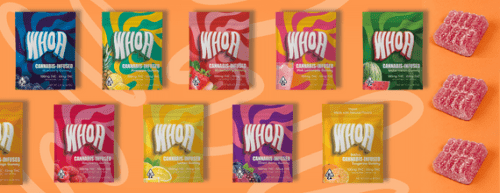Bud rot, or botrytis cinerea, is a common type of fungal disease that has been a nuisance for growers and cannabis cultivators for centuries. Even the most experienced and advanced grow operations have at times fallen powerless when confronted by the forces of nature that generate bud rot in cannabis crops.
Bud rot is produced by a fungus that grows on cannabis plants when they are exposed to rapid changes in temperature and humidity. Typically, this produces a gray mold which then infects the entire plant. While this is a persistent menace for growers, in recent years, states like Colorado, California, Illinois, and Michigan have made claims that moldy cannabis, likely infested by bud rot, was legally sold to cannabis consumers in their respective states.
Now, we’ve all smoked some shwaggy brick flower before that categorically doesn’t even seem right to classify as ‘mids.’ You know the kind- discolored, funky smells, or worse, no smell at all. But what if the weed you purchased from a licensed medical or adult-use dispensary had mold on it? You would likely be hard pressed to find a smoker that is desperate enough to puff on rotting weed.
That’s why Respect My Region is here to provide a run-down of what bud rot is, how to identify if your stash is infected, and to also briefly go over the potential health risks associated with smoking moldy weed.
***PSA: Don’t smoke moldy weed.
What is bud rot?
According to growers, gray mold, or botrytis cinerea, is “an incredibly wide-spread disease, affecting a wide range of crops, including cannabis. It’s a type of mold, similar to powdery mildew and downy mildew.”
The mold can appear white at first, but then typically will turn into a light or dark brown rot; thus earning its name: bud rot.
According to the legend Ed Rosenthal:
“This fungus can germinate only on wet plant tissue when temperature is between 55-70o F. This often happens in dry weather as dew accumulates on the leaves. Once it starts growing it can tolerate a wide range of humidity and temperatures but high humidity and cool temperatures help it thrive.”
Ed Rosenthal’s Marijuana Grower’s Handbook, Ed Rosenthal, p.465
Bud rot is typically difficult to spot early in the grow process; however, once the fungus has progressed, the infected cannabis must be removed and separated in its entirety from other healthy plants to prevent any further spread of the fungus.

Classic signs of bud rot | Photo via Reddit
How is it possible to purchase weed infected by bud rot?
There are very strict regulations on cannabis, varying state by state, that requires comprehensive laboratory testing prior to it entering the stream of commerce. So you’re probably wondering, “how is it possible to purchase legal weed that is moldy or rotten?”
One possible theory is quality control. With larger MSO’s controlling the market share, it’s possible that mass production has led to a decline in the quality of the cannabis.
Another possible theory is that bud rot can be difficult to detect. While it’s true that experienced cultivators can usually recognize it early on if there are obvious signs, there are conflicting reports regarding how bud rot presents itself. Consequently, some growers found that this fungus, which produces bud rot, has no significant smell or odor and can sometimes only be detected through microscopic review.
Moreover, given the fact that the plant’s genetics have been so vastly manufactured, producing a myriad of colors and shapes, it can be hard to determine if the bud is discolored due to its genes or if it’s the product of a disease.

Image via ILoveGrowingMarijuana
Is your stash infected by bud rot?
Mold is regularly identifiable by the naked eye in everyday things; example: if your cheese is a raging lime green color, this is usually a clear indication that it’s rotten. When it comes to cannabis, it’s a little different.
To start, what you want to look for if you’re concerned that your cannabis has bud rot is a grayish, almost web-like mold growing on the inside of the buds. You can break your nugs apart and search for this. The second indication of bud rot is typically discoloration; this will present as a light brown, gold, or yellow color.
If you’re not convinced by what you see through examining the exterior of the buds, then you can move on to a smell test. Bud rot and moldy weed will not produce the pungent diesel and lemon-stank that consumers have come to know and love; rather, it will smell unusually off-putting. Weedmaps indicates that the smell of moldy weed will be “repulsive to the human nose.”
Therefore, if you dive in for a sniff-test and it’s pretty unbearable or smells like mildew, you might want to be concerned.
Why is smoking bud rot-infested weed potentially dangerous?
It seems rather obvious why you shouldn’t smoke moldy weed, but let’s go over the basics. If someone were to smoke weed that is infected by the fungus, then the person would inhale that fungus into their lungs. What’s the big deal? People eat blue cheese all the time? Correct, but for those with compromised immune systems, inhaling fungus can potentially produce a slew of different lung infections.
Moreover, if you’re someone who has allergies, mainly to mold-based antibiotics such as penicillin, then smoking moldy, rotten weed may be even more dangerous because it can potentially cause an allergic reaction.
As per Weedmaps, “A study published in “Clinical Microbiology and Infection” 2017 found molds such as Aspergillus, Mucor, and other potentially harmful fungi in cannabis samples procured from northern California dispensaries. By smoking moldy weed medical marijuana patients risk fungal infections and other problems.”
Therefore, it is widely advised not to combust and inhale moldy weed.
With recent reports that dispensaries across the nation have been known to sell moldy weed, it’s important that consumers stay vigilant and inspect their cannabis before consuming to mitigate the potential health risks associated with smoking moldy pot.
More Content
THE RELATIONSHIP BETWEEN BACKWOODS AND HIP-HOP
TERPENES FOR ANXIETY: 3 TERPS IN CANNABIS WITH STRESS-RELIEVING PROPERTIES
RAPPER WEED: WHICH RAPPERS HAVE CANNABIS PRODUCTS IN THE MARKET? WHO ACTUALLY HAS THE FIRE?
11 COMPANIES THAT DON’T DRUG TEST THEIR EMPLOYEES FOR WEED
7 TIPS FOR MARKETING CANNABIS AND CBD ON TIKTOK AND INSTAGRAM








